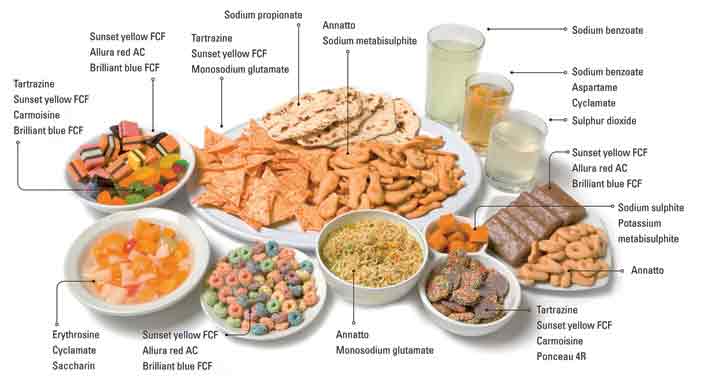Food additives are substances that are added to foods to improve shelf life, assist manufacturing or enhance their flavor, texture or colour.
Some examples include:
- Beeswax is a glazing agent (901) often used to coat apples, aiding their appearance.
- Sorbitol is a humectant (420) often mixed in with dried fruits to extend their shelf life and maintain their soft texture and moisture.
- Sodium nitrite (250) and sodium nitrate (251) are often added to processed meats as a preservative and to help maintain their colour.
Additives and processed food go hand in hand. As a general rule, the more processed a food is, the more additives are likely to be present. The Western world is bombarded with food advertising and supermarket shelves laden with processed food products. So much so, that these products are an everyday part of the modern diet.
Important to note, there are many naturally occurring substances that are also used as additives.
Some examples include:
- Lecithin (322), an antioxidant naturally present in sunflower seeds, egg yolks and soya beans is often added to chewing gum, edible oils, milk powder and cosmetics.
- Curcumin (100) is the active ingredient of turmeric and provides for the deep orange colour of certain processed foods, desserts and pharmaceuticals.
A dietary pattern flavouring the regular consumption of processed foods can results in increased risk of chronic disease and illness. It is also important to remember that 80% of illness stems from environmental factors. Food additives can also cause issues when consumed in excess (as seen in the Western diet) or when one has a sensitivity. They have also been linked to hyperactivity, attention-deficit disorders, allergies, hormone imbalance and much more.
Here are some general rules of thumb when it comes to identifying additives in our food.
- Colours: these, like the name suggest, add or restore the colour of our food.
- Code numbers within the 100 range
- Preservatives: these help preserve a food from deterioration, lengthening their shelf life.
- Code numbers within the 200 range
- Antioxidants: these slow/prevent the oxidation of food.
- Code numbers within the 300 range
- Artificial sweeteners: exert a sweet taste equivalent to that of sugar, without the energy of sugar itself.
- Code numbers within the 900 range (i.e. intense sweeteners e.g. xylitol) and 400 range (i.e. bulk sweeteners e.g. sorbitol).
- Flavour enhancers: these, like the name suggests, improve the flavor/aroma of a food.
- Code numbers mainly within the 600 range
- Emulsifiers: these helps prevent the separation of oil-based and water-based products such as mayonnaise and marinades.
- Code numbers mainly within the 400 range
- Thickeners: these increase the viscosity of foods to a more desirable consistency.
- Code numbers mainly within the 400 range and 1000 range (modified starches)
- Stabilisers: these maintain the uniformity of food particles, so as to avoid separation and clumping.
- Code numbers mainly within the 400 range
See the following diagram for some more insight into just how much is hidden in the food we eat!
You can get a list of all the current food additives passed in Australia as well as their codes here – Food Standards Australia and New Zealand.
The moral of this story, it is always best to favour a diet rich in fresh wholefoods and lighter processed foods such as tinned beans and fish. I encourage you to always read your labels. If you need a little more help with that – see this blog post for more – Ask Alex: How to decode a food label and its nutrition claim/s?

